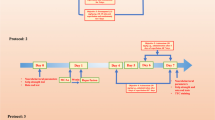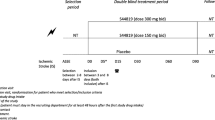Abstract
Background and purpose A low-affinity, use-dependent N-Methyl-D-Aspartate (NMDA) antagonist AR-R15896AR has neuroprotective properties in animal models of ischaemic stroke. The aim of the present study was to examine the safety and tolerability of a new and higher dosage regimen that would enable acute stroke patients to achieve and maintain neuroprotective plasma concentrations. Methods A randomised, multi-centre, double-blind, placebo-controlled, parallel group study was carried out at 19 centres in France, Germany and the Netherlands in patients with a clinical diagnosis of acute ischaemic stroke, and onset of symptoms within 12 hours before start of study drug administration. Two loading doses of 3.5 mg/kg of AR-R15896AR over 60 minutes, followed by a 2.5 mg/kg infusion over the next 120 minutes were given. Eight hours after the start of the loading dose infusion, the first maintenance dose (120 mg) was administered over 60 minutes. Eight further maintenance infusions were administered at intervals of 8 hours over a total treatment period of 3 days. Main variables were safety, tolerability and pharmacokinetics. Follow-up assessments also included the Barthel Index (BI) and the NIH Stroke Scale (NIHSS) at 4–7 days after the end of the last infusion and at 30 days after the onset of stroke. Results 103 patients with acute ischaemic stroke were randomised to either treatment with AR-R15896AR (70 patients) or placebo (33 patients). Mortality was not significantly different in the AR-R15896AR group compared with the placebo group (10 % vs. 6 %). Serious adverse events during treatment due to psychiatric conditions were associated with AR-R15896AR (3 vs. 0). Other side effects were more common in the group treated with AR-R15896AR: vomiting (29 % vs. 9 %), nausea (23 % vs. 12 %), fever (17 % vs. 12 %), agitation (7 % vs. 3 %), dizziness (7 % vs. 0 %), and hallucinations (6 % vs. 0 %). No significant difference between the two groups (with respect to the proportions of patients with favourable outcome) was detected in either the analysis of the BI or the NIHSS. Pharmacokinetic data showed that plasma concentrations of AR-R15896AR were in the expected neuroprotective range. Conclusion In most of the patients with acute stroke receiving AR-R15896AR the intended high plasma levels were reached within a short time period. However, active treatment produced more side effects than placebo, thus indicating safety concerns and tolerability issues for use in high doses in an acute stroke population.
Similar content being viewed by others
Author information
Authors and Affiliations
Consortia
Additional information
Received: 20 June 2001, Received in revised form: 26 September 2001, Accepted: 5 October 2001
Rights and permissions
About this article
Cite this article
Diener, HC., AlKhedr, A., Busse, O. et al. Treatment of acute ischaemic stroke with the low-affinity, use-dependent NMDA antagonist AR-R15896AR. J Neurol 249, 561–568 (2002). https://doi.org/10.1007/s004150200065
Published:
Issue Date:
DOI: https://doi.org/10.1007/s004150200065




